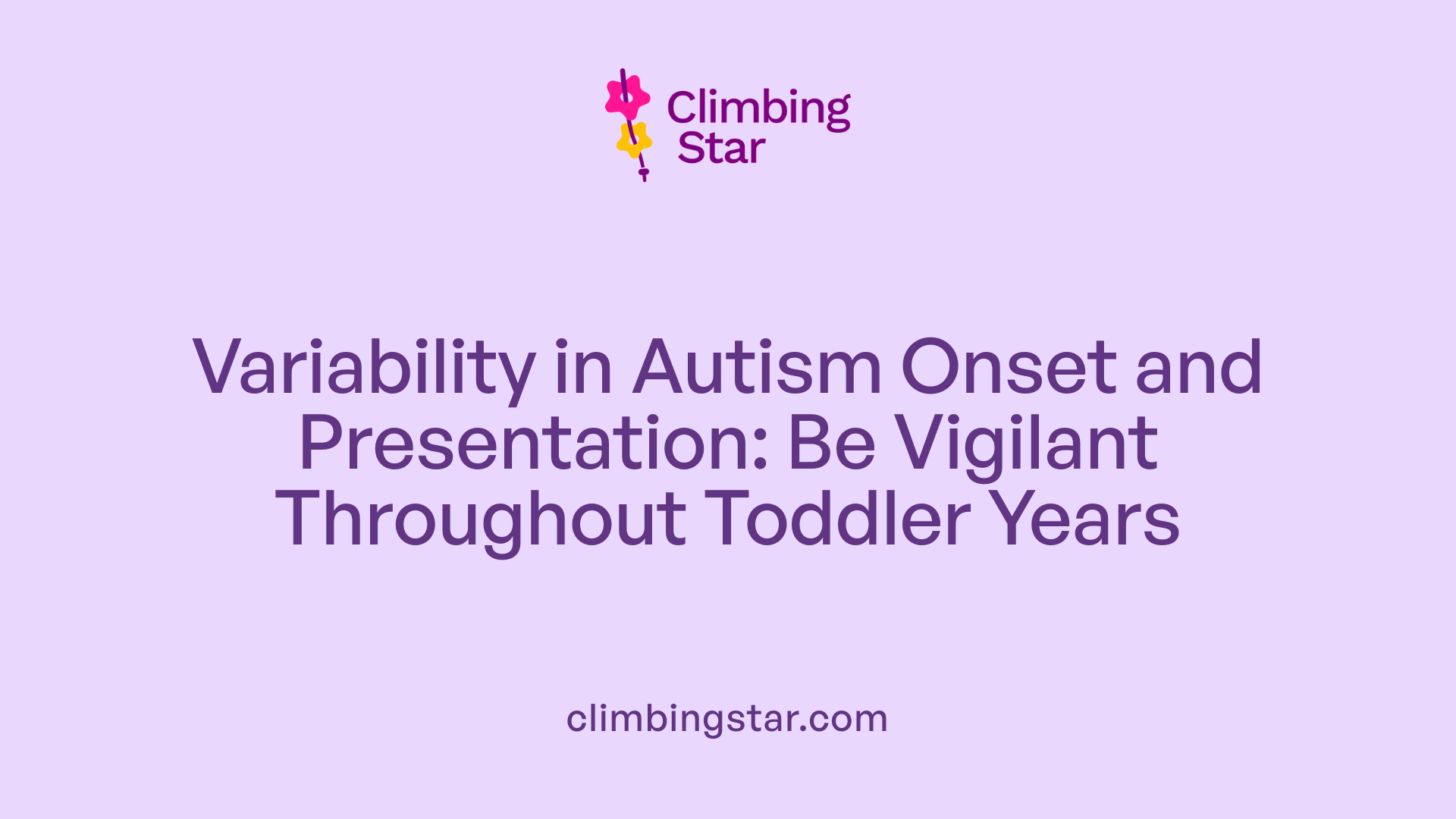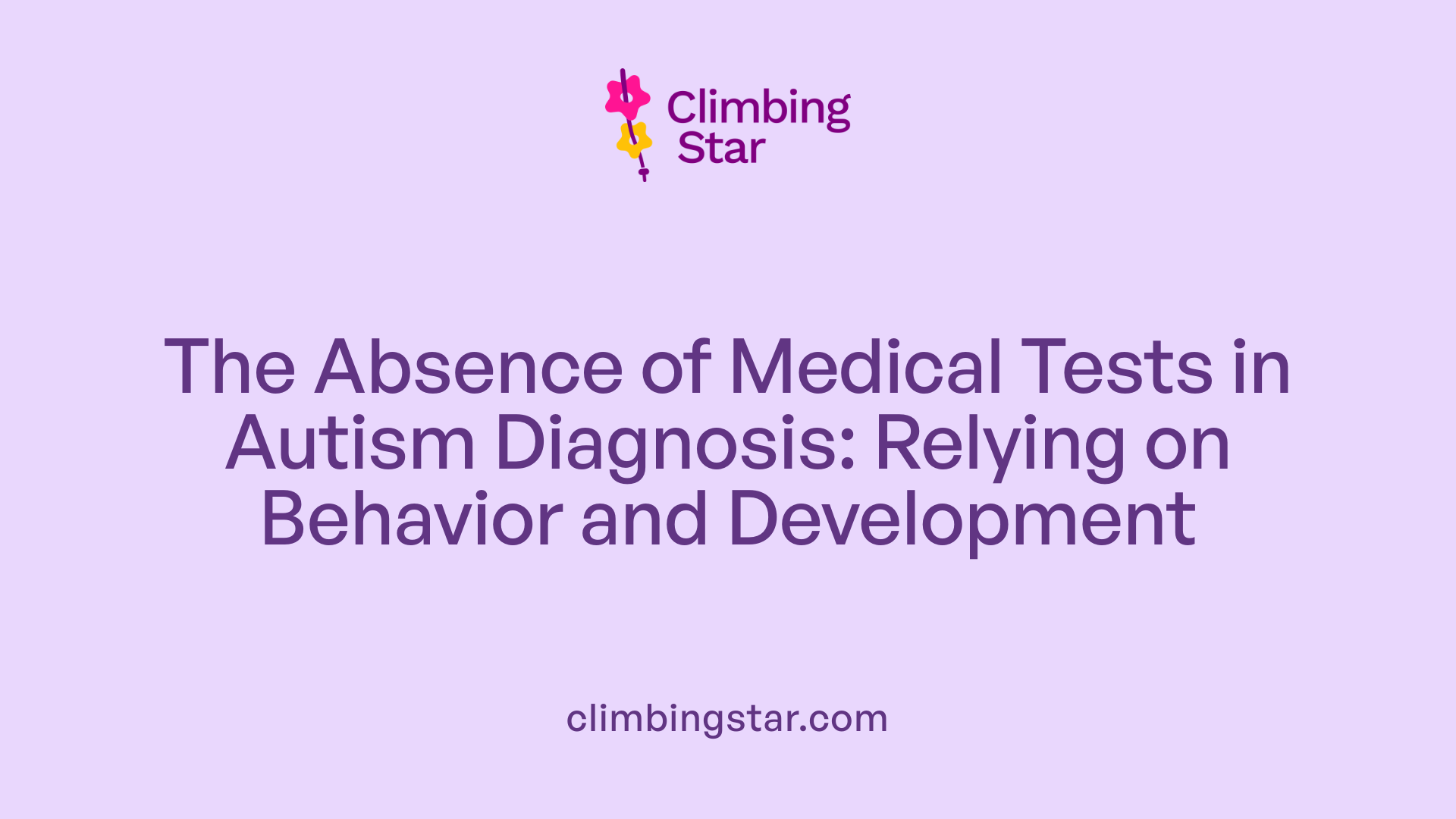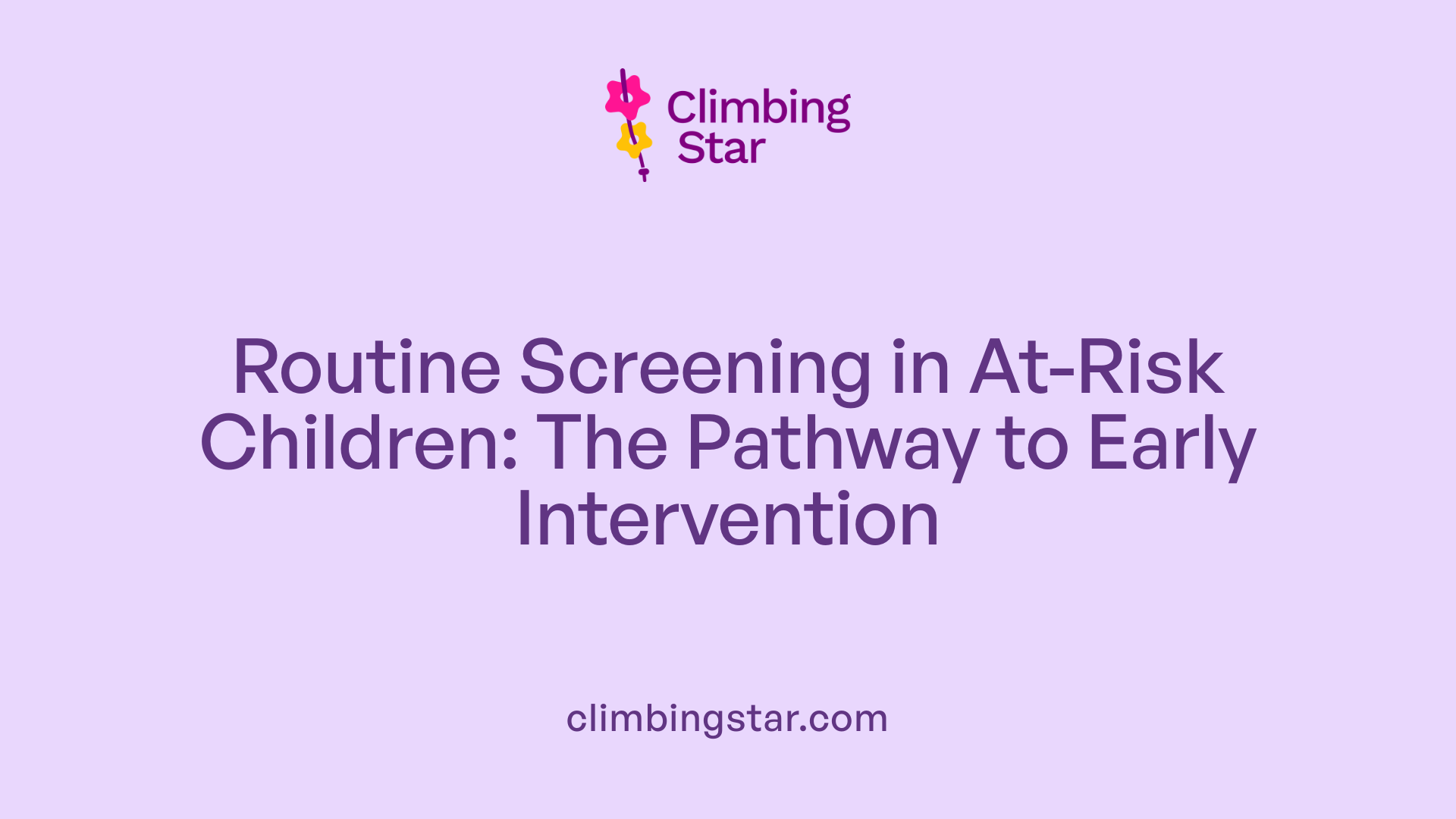Why Early Diagnosis Matters
Autism Spectrum Disorder (ASD) is a complex neurodevelopmental condition that begins early in childhood, often before the age of three. Recognizing the signs and obtaining an early diagnosis is crucial for accessing timely interventions that can significantly improve developmental outcomes and quality of life. This article explores when and how autism is diagnosed, the role of behavioral therapies, and the importance of family involvement in supporting individuals with autism.
Early Signs and Age of Diagnosis

What Are the Typical Early Signs of Autism in Infants and Toddlers?
Early signs of autism spectrum disorder (ASD) often emerge between 9 and 36 months of age. Infants may show limited or no eye contact, decreased response when their name is called, and a lack of typical social behaviors such as babbling or pointing by 12 months. Toddlers might also exhibit delayed language development, unusual sensory responses, repetitive movements like hand flapping, and a strong resistance to changes in routine. These behaviors reflect difficulties in social communication, interaction, and restricted, repetitive behaviors characteristic of ASD.
At What Ages Are Screening and Diagnosis Recommended?
The American Academy of Pediatrics recommends screening all children for ASD at 18 and 24 months during routine well-child visits. Clinical diagnosis can be reliably made as early as 2 years old by experienced professionals, though many children are diagnosed later, with the average age around 4.5 years. Early recognition through screening tools like the Modified Checklist for Autism in Toddlers, Revised with Follow-Up (M-CHAT-R/F) helps prompt timely evaluations and interventions.
What Challenges Exist in Recognizing Autism Early?
Several factors make early diagnosis challenging. Symptom presentation varies widely among children, with some showing very subtle signs, while others may have overlapping conditions such as ADHD or anxiety. Cultural and social factors can influence when signs become noticeable. Additionally, there is no specific medical test—diagnosis relies on careful behavioral observation and history, which can delay identification if early developmental monitoring is inconsistent.
How Variable Is the Onset and Presentation of Symptoms?
ASD symptoms can appear within the first year or may not become evident until later in toddlerhood or even infancy. Some children show regression, losing previously acquired social or language skills during the second year. The spectrum itself includes a wide range of strengths and challenges, with symptom severity varying and sometimes camouflaged, especially in older children or females. This variability calls for vigilant screening and ongoing observation.
When Is Autism Typically Diagnosed?
Autism can reliably be diagnosed as early as age 2, although many children receive a diagnosis later. Early signs can appear between 9 and 36 months and include limited eye contact, lack of response to their name, delayed language, and repetitive behaviors. Early diagnosis is challenging due to symptom variability and overlap with other conditions, but routine screening at 18 and 24 months during well-child visits is recommended to improve early detection.
The Diagnostic Process for Autism Spectrum Disorder

How is autism diagnosed?
Diagnosing Autism Spectrum Disorder (ASD) relies primarily on clinical evaluation rather than medical laboratory tests. Since no blood test or brain scan can definitively identify autism, specialists focus on behavioral observations and developmental history to make a diagnosis.
Behavioral observation and developmental history
Observation of the individual’s behavior is central to diagnosis. Clinicians watch for difficulties in social communication and interaction, as well as restricted or repetitive behaviors. Gathering comprehensive developmental history from parents or caregivers is equally important, providing insight into early signs such as reduced eye contact, delayed speech, or lack of response to name.
Use of standardized screening and diagnostic tools
Standardized tools help ensure consistency and accuracy in diagnosis. Common screening questionnaires like the Modified Checklist for Autism in Toddlers (M-CHAT) are used during early childhood screenings at 18 and 24 months. For formal diagnosis, tools such as the Autism Diagnostic Observation Schedule (ADOS) and criteria set forth in the Diagnostic and Statistical Manual of Mental Disorders (DSM-5) guide clinicians in recognizing autism's core features.
Role of multidisciplinary teams
Diagnosis typically involves a team of professionals—including psychologists, developmental pediatricians, and neurologists. This multidisciplinary approach combines behavioral assessments, cognitive and language testing, and medical evaluations to rule out other conditions that might mimic or coexist with ASD. Parent interviews provide essential context to understand the child’s social and communication abilities.
Absence of medical tests for definitive diagnosis
Unlike many conditions, ASD lacks a definitive biomarker or lab test for diagnosis. Instead, the process relies on clinical judgment supported by objective rating scales and observational methods. Researchers continue to explore biological markers and advanced technologies, but as of now, the diagnosis remains a comprehensive behavioral and developmental evaluation.
This approach ensures early and accurate identification of ASD, enabling timely intervention that can significantly improve long-term outcomes.
Screening and Risk Factors: Who Should Be Monitored Closely?

Who is at higher risk for autism and should be screened early?
Children who are at increased risk for autism spectrum disorder (ASD) include those with a sibling already diagnosed with ASD, as well as children with specific genetic or chromosomal conditions like fragile X syndrome and tuberous sclerosis. Additionally, premature infants, children who experienced complications during birth, and those born to older parents are more susceptible to developing ASD.
Common risk factors associated with ASD
Several factors contribute to a higher likelihood of ASD, including:
- Family history of ASD
- Genetic and chromosomal conditions (fragile X syndrome, tuberous sclerosis)
- Birth complications and premature birth
- Older parental age at the time of birth
These risk factors highlight the need for heightened vigilance in monitoring developmental milestones in these children.
Importance of routine screening in at-risk children
Routine screening plays a critical role in early identification, especially for children at higher risk. The American Academy of Pediatrics recommends that all children undergo developmental screening for ASD at ages 18 and 24 months. Early screening ensures that children who show early signs—such as reduced eye contact, delayed speech, or limited social interaction—are promptly evaluated and can receive early intervention services, which are demonstrated to significantly improve developmental outcomes.
Genetic and environmental contributors
While there is no single known cause of ASD, both genetics and environmental factors contribute to its development. Genetic predispositions, as seen in familial ASD and associated conditions, interact with environmental influences, possibly including prenatal and perinatal factors, to increase risk.
Role of family history
Having a first-degree relative with ASD is one of the most significant risk factors. This familial link underscores the importance of monitoring and screening children from families with a known history of autism to facilitate early diagnosis and intervention.
| Risk Factor | Description | Importance for Screening |
|---|---|---|
| Family History | Having a sibling or parent with ASD | High priority for early and frequent screening |
| Genetic Conditions | Fragile X syndrome, tuberous sclerosis | Identifies children needing specialized monitoring |
| Birth Complications | Prematurity, oxygen deprivation, or other difficulties | Associated with increased ASD risk; warrants screening |
| Parental Age | Older parents at time of birth | Increases risk slightly; encourages vigilant monitoring |
Early and routine screening of at-risk children not only supports timely diagnosis but also opens access to early interventions that greatly improve long-term social, cognitive, and behavioral outcomes.
Applied Behavior Analysis (ABA) Therapy: Foundations and Uses
What is applied behavior analysis (ABA) therapy and how is it used to support individuals with autism?
Applied Behavior Analysis (ABA) therapy is a scientifically supported intervention based on the principles of learning and behavior. It focuses on encouraging positive, helpful behaviors while reducing those that can be harmful or interfere with learning. ABA aims to promote skills essential for social interaction, communication, daily living, and academics by breaking tasks into manageable steps and teaching them systematically.
Behavioral techniques and goal-setting
ABA uses specific behavioral techniques such as positive reinforcement, where desired behaviors are rewarded to increase their occurrence. A key tool is the ABC model—Antecedent (what happens before a behavior), Behavior (the behavior itself), and Consequence (what happens after)—to analyze and modify behavioral patterns. Goals are individualized and clearly defined, based on the person’s abilities and needs, allowing for consistent tracking of progress over time.
Settings and methods of delivery
ABA therapy is versatile and can be delivered in various settings including the individual’s home, school, and community. It is typically provided by trained therapists, often in an intensive format involving multiple hours each week. The therapy is personalized, adapting methods to suit individual learning styles and specific developmental goals.
Effectiveness and research backing ABA
Research strongly supports ABA as an effective early intervention for children with autism spectrum disorder. It has been shown to significantly improve cognitive abilities, language skills, social interaction, and adaptive behaviors. Early and intensive ABA interventions have demonstrated long-lasting benefits, sometimes even shifting diagnostic severity. The approach leverages early childhood neuroplasticity to enhance developmental trajectories, making ABA a cornerstone in autism support strategies.
Benefits and Impact of Specialized Behavioral Therapies
Improvements in communication and social skills
Specialized behavioral therapies, such as Applied Behavior Analysis (ABA), help individuals with autism develop essential communication and social abilities. These therapies focus on teaching language skills, social interaction, and appropriate responses, enabling children to better understand and engage with others. Progress in these areas promotes stronger relationships at home, school, and in the community.
Reduction of challenging behaviors
Behavioral therapies work by applying positive reinforcement and environmental modifications to reduce behaviors that may interfere with learning and social participation. Challenging behaviors like repetitive movements, resistance to change, or tantrums can be addressed through consistent, structured interventions, leading to improved emotional regulation and smoother daily experiences.
Enhancement of independence and quality of life
Through improving communication and reducing problematic behaviors, specialized therapies boost a child's ability to perform daily living skills independently. This growth enhances their overall quality of life, allowing them to participate more fully in everyday activities and gain confidence.
Importance of early intervention
Starting behavioral therapies as early as possible, ideally before age 3, leverages the brain’s neuroplasticity to maximize developmental gains. Early intervention has been shown to produce significant improvements in IQ, language, adaptive behavior, and social skills over time.
Continuous evaluation ensures therapy remains personalized and effective, helping individuals with autism reach their fullest potential and fostering positive outcomes for families and society alike.
The Role and Qualifications of Professionals Delivering Behavioral Therapies
Who Typically Provides Behavioral Therapies for Autism and What Qualifications Do These Professionals Hold?
Behavioral therapies for autism spectrum disorder (ASD) are primarily delivered by a multidisciplinary team of professionals qualified in applied behavior analysis (ABA) and related fields. Key providers include Board Certified Behavior Analysts (BCBAs), Registered Behavior Technicians (RBTs), psychologists, developmental pediatricians, and psychiatrists.
Types of Professionals Involved in Behavioral Therapy
- Board Certified Behavior Analysts (BCBAs): These professionals typically hold a master's degree and have earned certification from the Behavior Analyst Certification Board (BACB). They conduct assessments, develop treatment plans, and supervise therapy delivery.
- Registered Behavior Technicians (RBTs): RBTs often have formal training and certification but work under the supervision of BCBAs. They implement therapy plans directly with children.
- Psychologists and Pediatricians: These experts are frequently involved in diagnosing ASD through clinical evaluation and may also contribute to therapy planning.
- Psychiatrists: They often address co-occurring conditions and medication management.
Roles in Diagnosis and Therapy Delivery
Psychologists, developmental pediatricians, and psychiatrists typically perform the initial and ongoing diagnostic assessments. BCBAs oversee and tailor the behavioral interventions based on individual needs, while RBTs provide direct, hands-on therapy.
Collaboration with Families
Families and caregivers play an essential role in the therapeutic process. Professionals provide training and education to help them support treatment goals at home, creating a collaborative approach that enhances outcomes for children.
This team-based model ensures that interventions are comprehensive, ethically grounded, and personalized to maximize developmental gains for individuals with ASD.
How ABA Therapy Differs from Other Autism Interventions
How does ABA therapy differ from other autism therapies?
Applied Behavior Analysis (ABA) therapy distinguishes itself from other autism interventions through its structured, data-driven, and individualized approach. While therapies like speech, occupational, and play therapy each target specific areas—communication skills, sensory and motor abilities, and social play respectively—ABA offers a comprehensive framework that addresses a broad spectrum of behaviors including social interaction, communication, and adaptive skills.
ABA therapy relies heavily on repetition and positive reinforcement. By breaking down complex behaviors into smaller, manageable tasks, it encourages consistent practice and rewards to promote meaningful behavioral changes. This methodical approach ensures treatment plans are tailored and adjusted based on measurable progress, fostering improved outcomes.
Moreover, unlike therapies focused solely on autism, ABA's principles are applicable to other developmental and behavioral conditions such as Attention Deficit Hyperactivity Disorder (ADHD) and Obsessive-Compulsive Disorder (OCD). This versatility demonstrates ABA's wide-ranging effectiveness beyond the autism spectrum.
In summary, ABA therapy’s unique emphasis on data tracking, individualized plans, and reinforcement strategies sets it apart from other interventions, aiming not only to develop specific skills but also to promote lasting independence and improvement in daily functioning.
Families: Essential Partners in Autism Therapy Success
What role do families play in the effectiveness of behavioral therapies for autism?
Families play a pivotal role in the success of behavioral therapies for children with autism spectrum disorder. Their involvement is crucial because they reinforce therapeutic strategies beyond clinical settings, helping to create consistency in the child’s routine and environment. This reinforcement promotes the generalization of learned skills to real-world situations, significantly enhancing the child's developmental progress.
How does parental training and support contribute to therapy outcomes?
Parental training equips caregivers with the knowledge and tools needed to support their child’s growth effectively. Through training, parents learn behavioral techniques and communication strategies that complement therapy sessions, enabling them to address challenges promptly and encourage positive behaviors consistently. Support groups and counseling also help families manage stress and maintain motivation, fostering a nurturing environment that benefits the child’s social-emotional development.
What impact does family engagement have on child progress and quality of life?
Strong family engagement correlates with notable improvements in cognitive, language, and social skills for children with autism. When families participate actively, children often exhibit better adaptive behaviors, greater independence, and improved communication. Furthermore, engaged families tend to experience enhanced overall quality of life, as collaborative therapy approaches strengthen parent-child bonds and reduce familial stress.
What barriers limit family involvement, and how can engagement be enhanced?
Several barriers can hinder family involvement, including limited socioeconomic resources, lack of access to training, time constraints, and cultural differences. To overcome these obstacles, therapy programs must offer flexible scheduling, affordable or subsidized services, and culturally sensitive educational materials. Increased use of telehealth and community-based support can also expand access. Promoting clear communication and partnership between therapists and families encourages sustained engagement and optimized therapy outcomes.
The Importance of Timely Autism Diagnosis and Intervention
Understanding when autism can be diagnosed and the pathways to effective intervention is vital for families, clinicians, and communities. Early detection—ideally by age 2—and timely access to behavioral therapies like ABA can significantly improve outcomes in communication, social interaction, and adaptive functioning, setting a foundation for a more independent life. Professionals trained in evidence-based methods, coupled with active family participation, form the cornerstone of successful management. Continued awareness, routine screening, and multidisciplinary collaboration remain essential to meeting the diverse needs of individuals with autism throughout their lives.
References
- About Autism Spectrum Disorder
- Early Diagnosis of Autism Spectrum Disorder: A Review ...
- Autism spectrum disorder - Symptoms and causes
- Diagnosing and managing autism spectrum disorder
- Signs of autism
- Autism Spectrum Disorder (ASD) Symptoms & Causes
- Autism Screening & Assessments
- How Autism May Present at Different Ages
- Is ABA Therapy Only for Autism?
- ABA Therapy vs. Other Interventions: What's Best for Kids?







